FORD FUSION (AMERICAS) 2014 2.G Service Manual
Manufacturer: FORD, Model Year: 2014, Model line: FUSION (AMERICAS), Model: FORD FUSION (AMERICAS) 2014 2.GPages: 458, PDF Size: 27.89 MB
Page 41 of 458
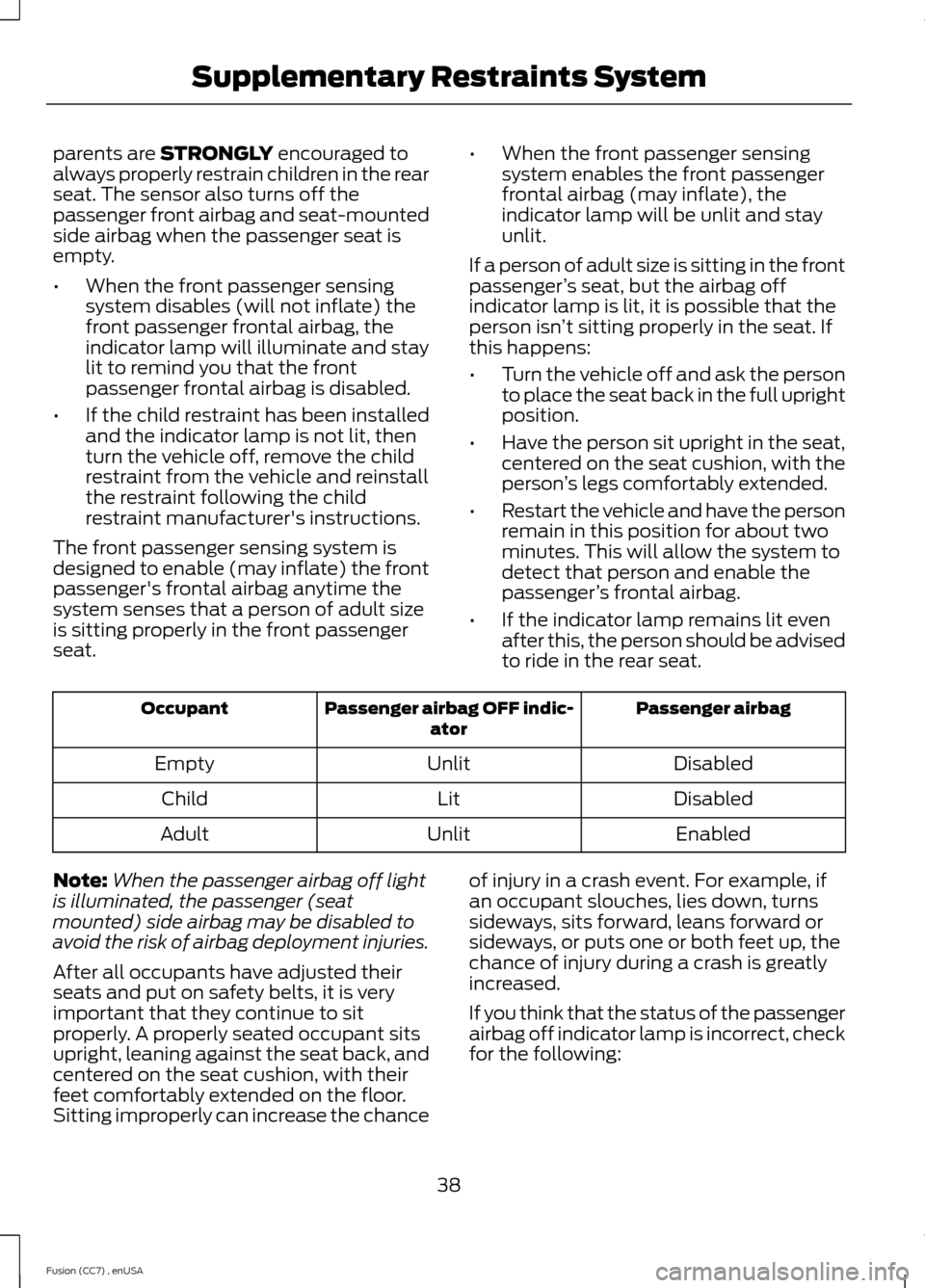
parents are STRONGLY encouraged toalways properly restrain children in the rearseat. The sensor also turns off thepassenger front airbag and seat-mountedside airbag when the passenger seat isempty.
•When the front passenger sensingsystem disables (will not inflate) thefront passenger frontal airbag, theindicator lamp will illuminate and staylit to remind you that the frontpassenger frontal airbag is disabled.
•If the child restraint has been installedand the indicator lamp is not lit, thenturn the vehicle off, remove the childrestraint from the vehicle and reinstallthe restraint following the childrestraint manufacturer's instructions.
The front passenger sensing system isdesigned to enable (may inflate) the frontpassenger's frontal airbag anytime thesystem senses that a person of adult sizeis sitting properly in the front passengerseat.
•When the front passenger sensingsystem enables the front passengerfrontal airbag (may inflate), theindicator lamp will be unlit and stayunlit.
If a person of adult size is sitting in the frontpassenger’s seat, but the airbag offindicator lamp is lit, it is possible that theperson isn’t sitting properly in the seat. Ifthis happens:
•Turn the vehicle off and ask the personto place the seat back in the full uprightposition.
•Have the person sit upright in the seat,centered on the seat cushion, with theperson’s legs comfortably extended.
•Restart the vehicle and have the personremain in this position for about twominutes. This will allow the system todetect that person and enable thepassenger’s frontal airbag.
•If the indicator lamp remains lit evenafter this, the person should be advisedto ride in the rear seat.
Passenger airbagPassenger airbag OFF indic-atorOccupant
DisabledUnlitEmpty
DisabledLitChild
EnabledUnlitAdult
Note:When the passenger airbag off lightis illuminated, the passenger (seatmounted) side airbag may be disabled toavoid the risk of airbag deployment injuries.
After all occupants have adjusted theirseats and put on safety belts, it is veryimportant that they continue to sitproperly. A properly seated occupant sitsupright, leaning against the seat back, andcentered on the seat cushion, with theirfeet comfortably extended on the floor.Sitting improperly can increase the chance
of injury in a crash event. For example, ifan occupant slouches, lies down, turnssideways, sits forward, leans forward orsideways, or puts one or both feet up, thechance of injury during a crash is greatlyincreased.
If you think that the status of the passengerairbag off indicator lamp is incorrect, checkfor the following:
38Fusion (CC7) , enUSASupplementary Restraints System
Page 42 of 458
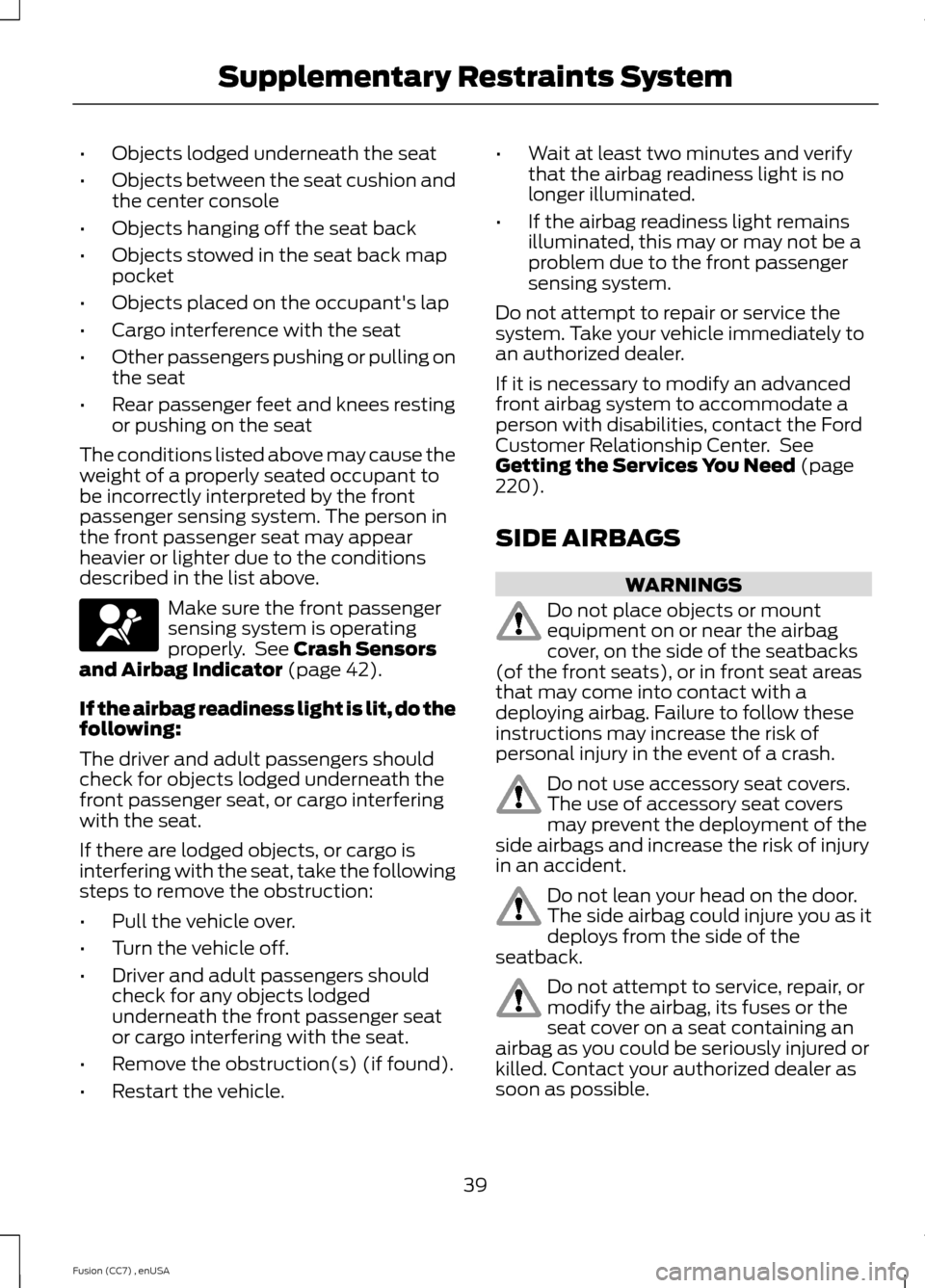
•Objects lodged underneath the seat
•Objects between the seat cushion andthe center console
•Objects hanging off the seat back
•Objects stowed in the seat back mappocket
•Objects placed on the occupant's lap
•Cargo interference with the seat
•Other passengers pushing or pulling onthe seat
•Rear passenger feet and knees restingor pushing on the seat
The conditions listed above may cause theweight of a properly seated occupant tobe incorrectly interpreted by the frontpassenger sensing system. The person inthe front passenger seat may appearheavier or lighter due to the conditionsdescribed in the list above.
Make sure the front passengersensing system is operatingproperly. See Crash Sensorsand Airbag Indicator (page 42).
If the airbag readiness light is lit, do thefollowing:
The driver and adult passengers shouldcheck for objects lodged underneath thefront passenger seat, or cargo interferingwith the seat.
If there are lodged objects, or cargo isinterfering with the seat, take the followingsteps to remove the obstruction:
•Pull the vehicle over.
•Turn the vehicle off.
•Driver and adult passengers shouldcheck for any objects lodgedunderneath the front passenger seator cargo interfering with the seat.
•Remove the obstruction(s) (if found).
•Restart the vehicle.
•Wait at least two minutes and verifythat the airbag readiness light is nolonger illuminated.
•If the airbag readiness light remainsilluminated, this may or may not be aproblem due to the front passengersensing system.
Do not attempt to repair or service thesystem. Take your vehicle immediately toan authorized dealer.
If it is necessary to modify an advancedfront airbag system to accommodate aperson with disabilities, contact the FordCustomer Relationship Center. SeeGetting the Services You Need (page220).
SIDE AIRBAGS
WARNINGS
Do not place objects or mountequipment on or near the airbagcover, on the side of the seatbacks(of the front seats), or in front seat areasthat may come into contact with adeploying airbag. Failure to follow theseinstructions may increase the risk ofpersonal injury in the event of a crash.
Do not use accessory seat covers.The use of accessory seat coversmay prevent the deployment of theside airbags and increase the risk of injuryin an accident.
Do not lean your head on the door.The side airbag could injure you as itdeploys from the side of theseatback.
Do not attempt to service, repair, ormodify the airbag, its fuses or theseat cover on a seat containing anairbag as you could be seriously injured orkilled. Contact your authorized dealer assoon as possible.
39Fusion (CC7) , enUSASupplementary Restraints System
Page 43 of 458
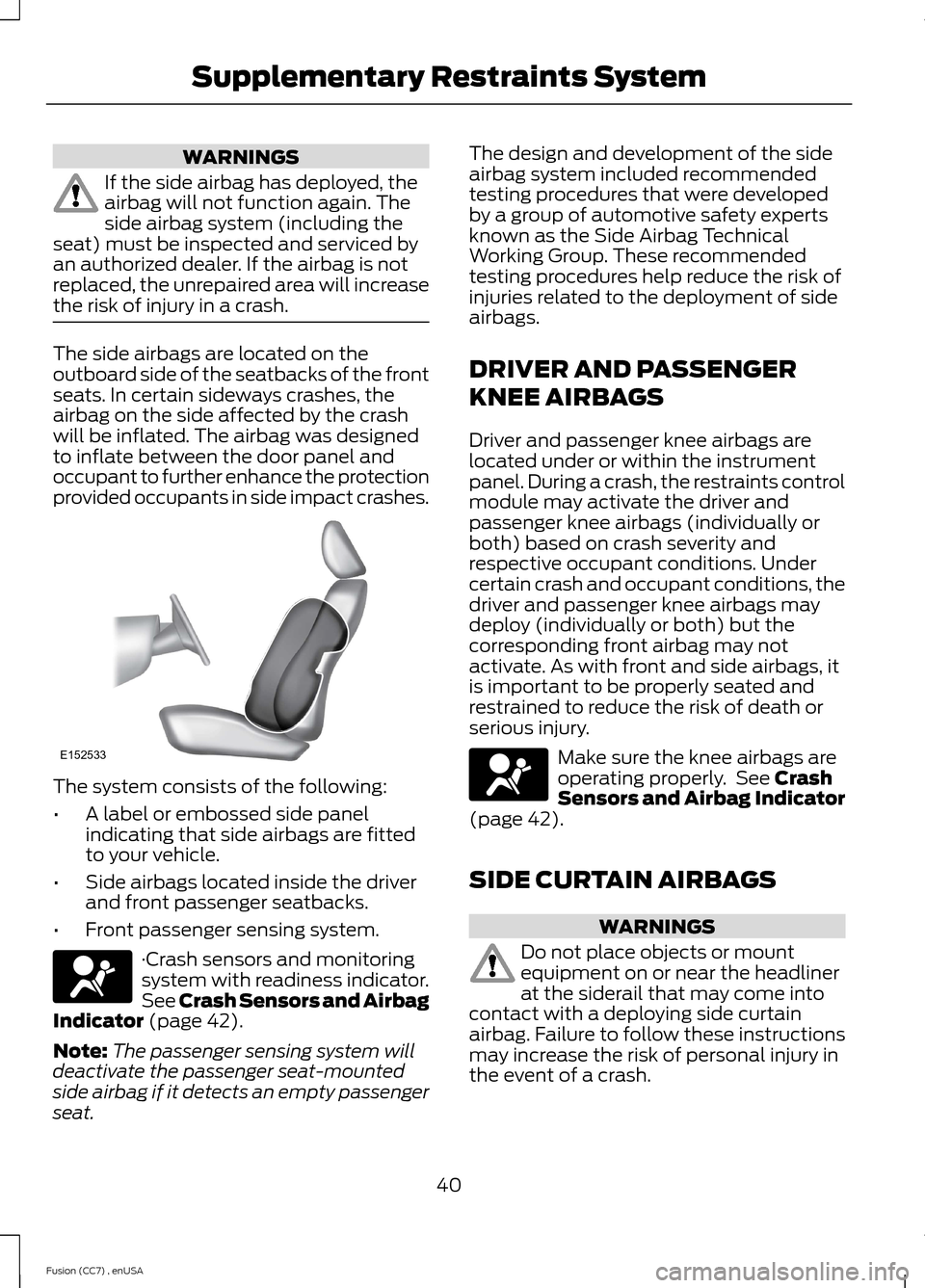
WARNINGS
If the side airbag has deployed, theairbag will not function again. Theside airbag system (including theseat) must be inspected and serviced byan authorized dealer. If the airbag is notreplaced, the unrepaired area will increasethe risk of injury in a crash.
The side airbags are located on theoutboard side of the seatbacks of the frontseats. In certain sideways crashes, theairbag on the side affected by the crashwill be inflated. The airbag was designedto inflate between the door panel andoccupant to further enhance the protectionprovided occupants in side impact crashes.
The system consists of the following:
•A label or embossed side panelindicating that side airbags are fittedto your vehicle.
•Side airbags located inside the driverand front passenger seatbacks.
•Front passenger sensing system.
·Crash sensors and monitoringsystem with readiness indicator.See Crash Sensors and AirbagIndicator (page 42).
Note:The passenger sensing system willdeactivate the passenger seat-mountedside airbag if it detects an empty passengerseat.
The design and development of the sideairbag system included recommendedtesting procedures that were developedby a group of automotive safety expertsknown as the Side Airbag TechnicalWorking Group. These recommendedtesting procedures help reduce the risk ofinjuries related to the deployment of sideairbags.
DRIVER AND PASSENGER
KNEE AIRBAGS
Driver and passenger knee airbags arelocated under or within the instrumentpanel. During a crash, the restraints controlmodule may activate the driver andpassenger knee airbags (individually orboth) based on crash severity andrespective occupant conditions. Undercertain crash and occupant conditions, thedriver and passenger knee airbags maydeploy (individually or both) but thecorresponding front airbag may notactivate. As with front and side airbags, itis important to be properly seated andrestrained to reduce the risk of death orserious injury.
Make sure the knee airbags areoperating properly. See CrashSensors and Airbag Indicator(page 42).
SIDE CURTAIN AIRBAGS
WARNINGS
Do not place objects or mountequipment on or near the headlinerat the siderail that may come intocontact with a deploying side curtainairbag. Failure to follow these instructionsmay increase the risk of personal injury inthe event of a crash.
40Fusion (CC7) , enUSASupplementary Restraints SystemE152533
Page 44 of 458
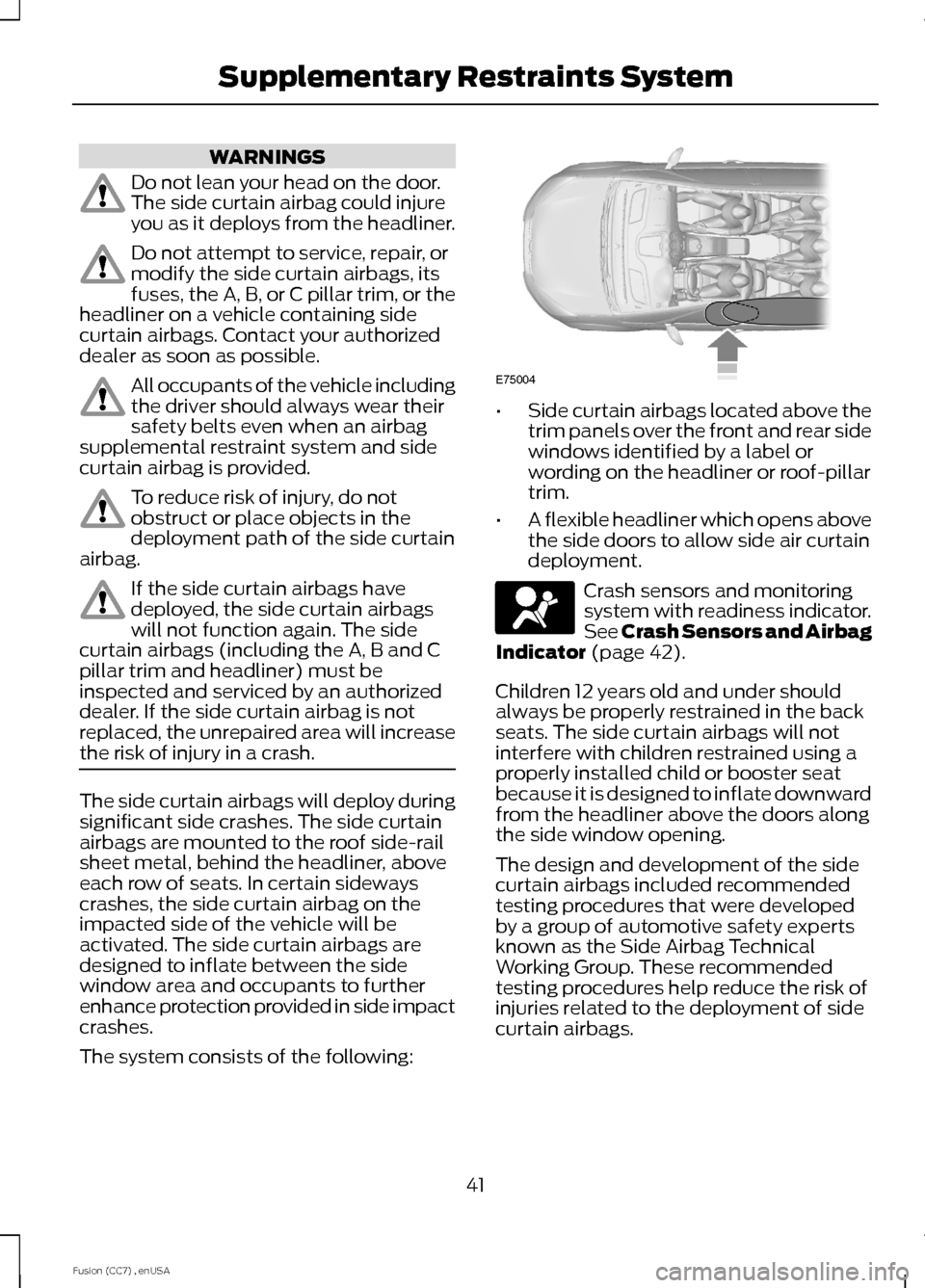
WARNINGS
Do not lean your head on the door.The side curtain airbag could injureyou as it deploys from the headliner.
Do not attempt to service, repair, ormodify the side curtain airbags, itsfuses, the A, B, or C pillar trim, or theheadliner on a vehicle containing sidecurtain airbags. Contact your authorizeddealer as soon as possible.
All occupants of the vehicle includingthe driver should always wear theirsafety belts even when an airbagsupplemental restraint system and sidecurtain airbag is provided.
To reduce risk of injury, do notobstruct or place objects in thedeployment path of the side curtainairbag.
If the side curtain airbags havedeployed, the side curtain airbagswill not function again. The sidecurtain airbags (including the A, B and Cpillar trim and headliner) must beinspected and serviced by an authorizeddealer. If the side curtain airbag is notreplaced, the unrepaired area will increasethe risk of injury in a crash.
The side curtain airbags will deploy duringsignificant side crashes. The side curtainairbags are mounted to the roof side-railsheet metal, behind the headliner, aboveeach row of seats. In certain sidewayscrashes, the side curtain airbag on theimpacted side of the vehicle will beactivated. The side curtain airbags aredesigned to inflate between the sidewindow area and occupants to furtherenhance protection provided in side impactcrashes.
The system consists of the following:
•Side curtain airbags located above thetrim panels over the front and rear sidewindows identified by a label orwording on the headliner or roof-pillartrim.
•A flexible headliner which opens abovethe side doors to allow side air curtaindeployment.
Crash sensors and monitoringsystem with readiness indicator.See Crash Sensors and AirbagIndicator (page 42).
Children 12 years old and under shouldalways be properly restrained in the backseats. The side curtain airbags will notinterfere with children restrained using aproperly installed child or booster seatbecause it is designed to inflate downwardfrom the headliner above the doors alongthe side window opening.
The design and development of the sidecurtain airbags included recommendedtesting procedures that were developedby a group of automotive safety expertsknown as the Side Airbag TechnicalWorking Group. These recommendedtesting procedures help reduce the risk ofinjuries related to the deployment of sidecurtain airbags.
41Fusion (CC7) , enUSASupplementary Restraints SystemE75004
Page 45 of 458
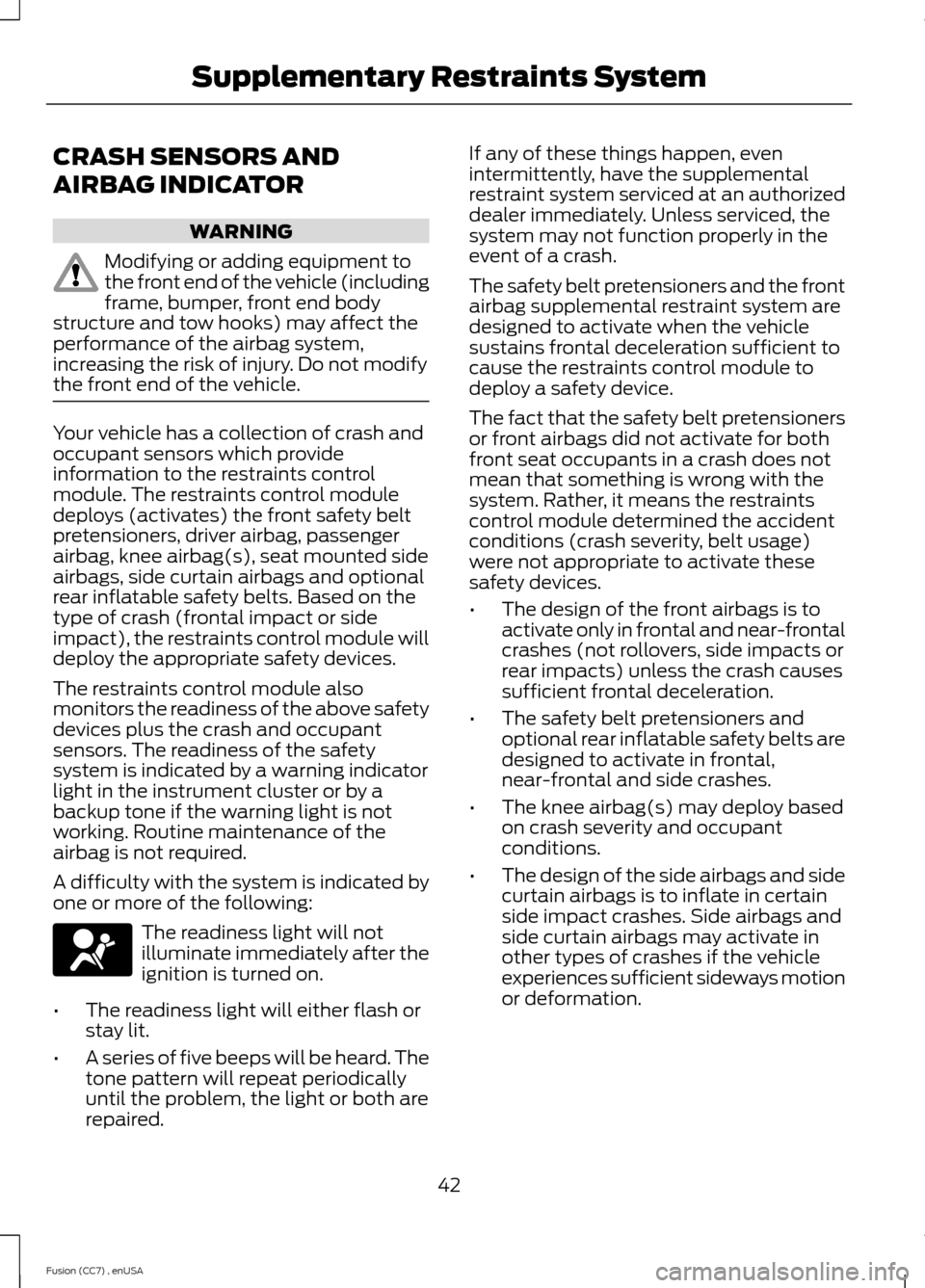
CRASH SENSORS AND
AIRBAG INDICATOR
WARNING
Modifying or adding equipment tothe front end of the vehicle (includingframe, bumper, front end bodystructure and tow hooks) may affect theperformance of the airbag system,increasing the risk of injury. Do not modifythe front end of the vehicle.
Your vehicle has a collection of crash andoccupant sensors which provideinformation to the restraints controlmodule. The restraints control moduledeploys (activates) the front safety beltpretensioners, driver airbag, passengerairbag, knee airbag(s), seat mounted sideairbags, side curtain airbags and optionalrear inflatable safety belts. Based on thetype of crash (frontal impact or sideimpact), the restraints control module willdeploy the appropriate safety devices.
The restraints control module alsomonitors the readiness of the above safetydevices plus the crash and occupantsensors. The readiness of the safetysystem is indicated by a warning indicatorlight in the instrument cluster or by abackup tone if the warning light is notworking. Routine maintenance of theairbag is not required.
A difficulty with the system is indicated byone or more of the following:
The readiness light will notilluminate immediately after theignition is turned on.
•The readiness light will either flash orstay lit.
•A series of five beeps will be heard. Thetone pattern will repeat periodicallyuntil the problem, the light or both arerepaired.
If any of these things happen, evenintermittently, have the supplementalrestraint system serviced at an authorizeddealer immediately. Unless serviced, thesystem may not function properly in theevent of a crash.
The safety belt pretensioners and the frontairbag supplemental restraint system aredesigned to activate when the vehiclesustains frontal deceleration sufficient tocause the restraints control module todeploy a safety device.
The fact that the safety belt pretensionersor front airbags did not activate for bothfront seat occupants in a crash does notmean that something is wrong with thesystem. Rather, it means the restraintscontrol module determined the accidentconditions (crash severity, belt usage)were not appropriate to activate thesesafety devices.
•The design of the front airbags is toactivate only in frontal and near-frontalcrashes (not rollovers, side impacts orrear impacts) unless the crash causessufficient frontal deceleration.
•The safety belt pretensioners andoptional rear inflatable safety belts aredesigned to activate in frontal,near-frontal and side crashes.
•The knee airbag(s) may deploy basedon crash severity and occupantconditions.
•The design of the side airbags and sidecurtain airbags is to inflate in certainside impact crashes. Side airbags andside curtain airbags may activate inother types of crashes if the vehicleexperiences sufficient sideways motionor deformation.
42Fusion (CC7) , enUSASupplementary Restraints System
Page 46 of 458
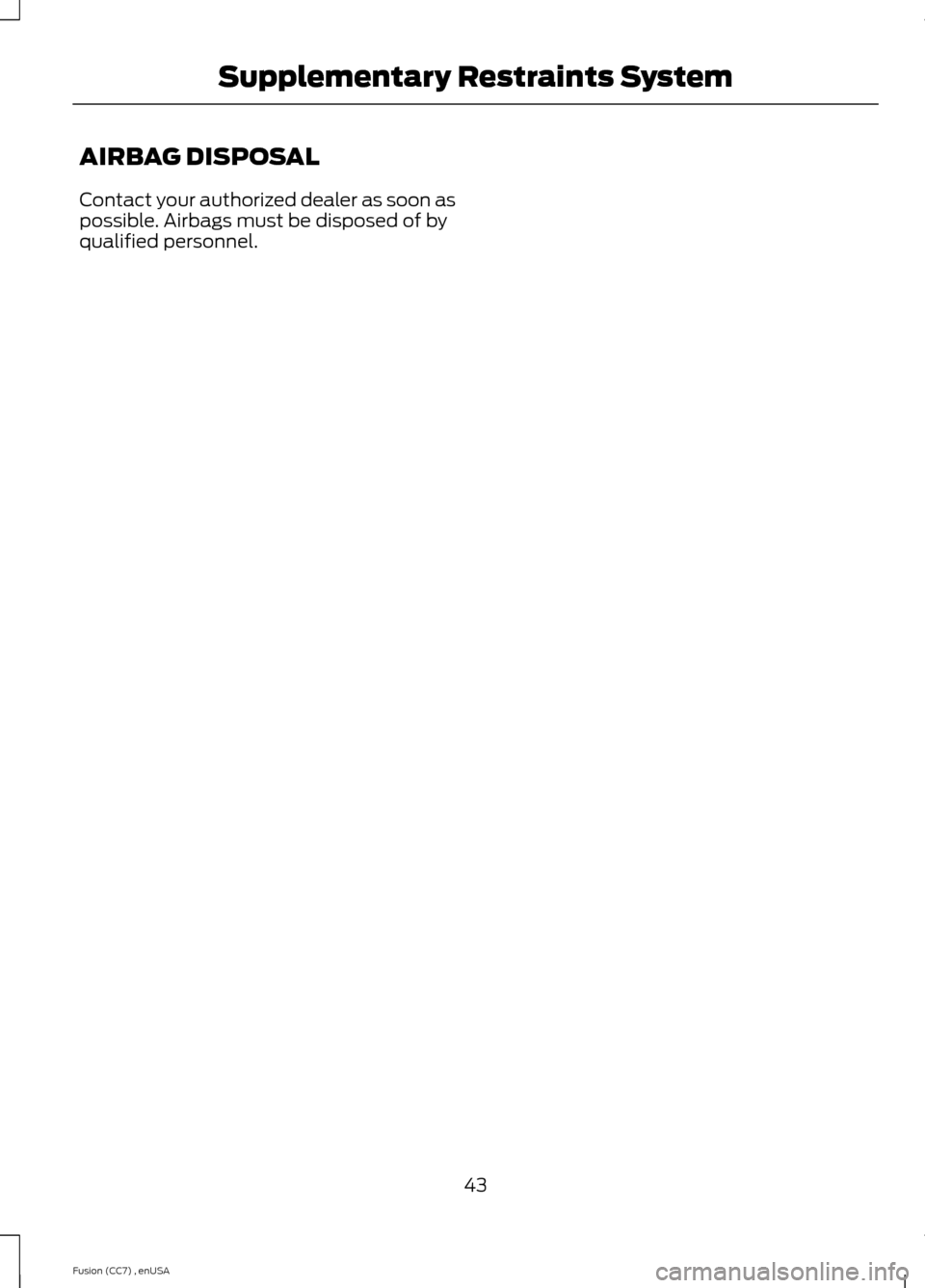
AIRBAG DISPOSAL
Contact your authorized dealer as soon aspossible. Airbags must be disposed of byqualified personnel.
43Fusion (CC7) , enUSASupplementary Restraints System
Page 47 of 458
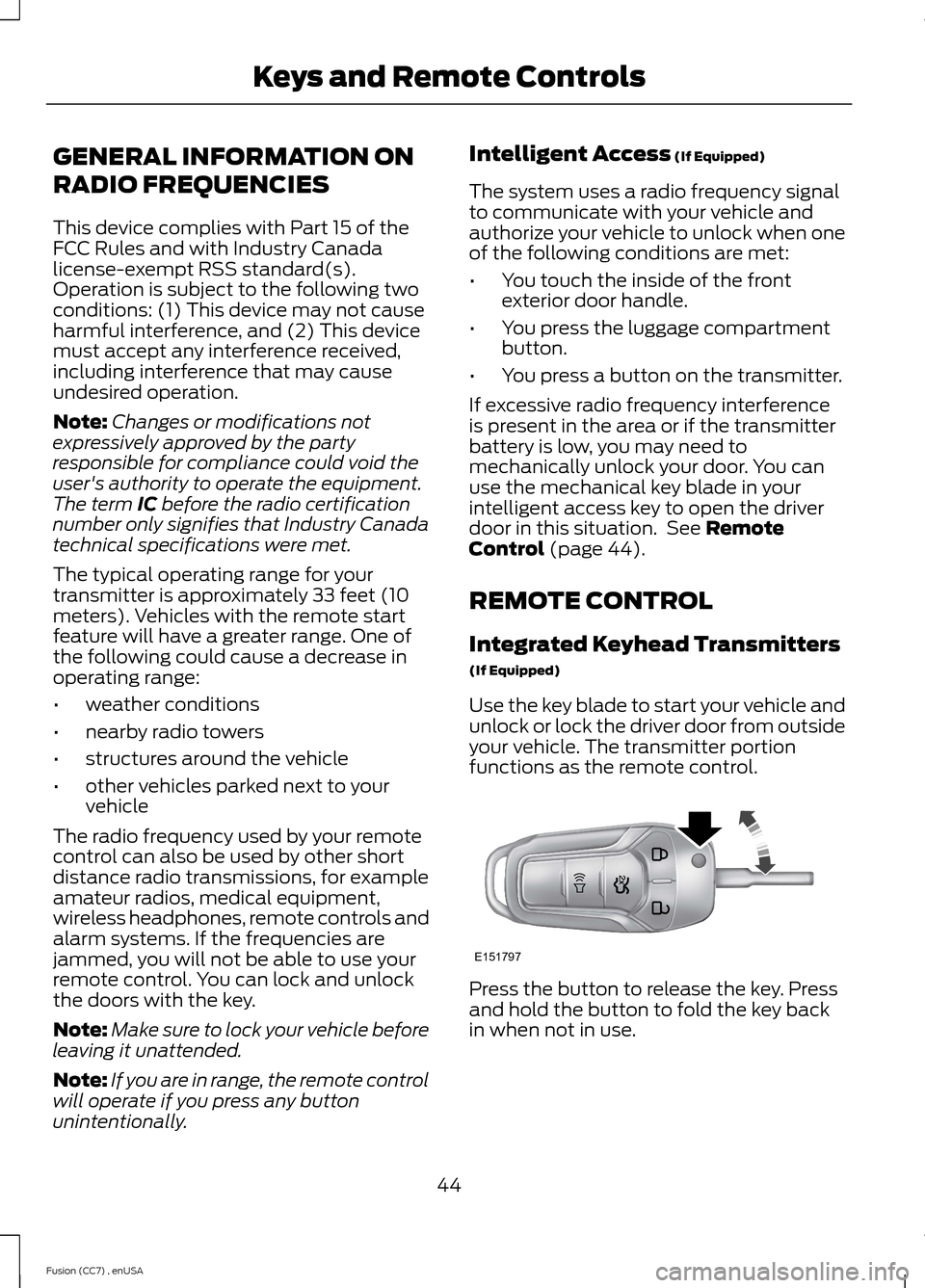
GENERAL INFORMATION ON
RADIO FREQUENCIES
This device complies with Part 15 of theFCC Rules and with Industry Canadalicense-exempt RSS standard(s).Operation is subject to the following twoconditions: (1) This device may not causeharmful interference, and (2) This devicemust accept any interference received,including interference that may causeundesired operation.
Note:Changes or modifications notexpressively approved by the partyresponsible for compliance could void theuser's authority to operate the equipment.The term IC before the radio certificationnumber only signifies that Industry Canadatechnical specifications were met.
The typical operating range for yourtransmitter is approximately 33 feet (10meters). Vehicles with the remote startfeature will have a greater range. One ofthe following could cause a decrease inoperating range:
•weather conditions
•nearby radio towers
•structures around the vehicle
•other vehicles parked next to yourvehicle
The radio frequency used by your remotecontrol can also be used by other shortdistance radio transmissions, for exampleamateur radios, medical equipment,wireless headphones, remote controls andalarm systems. If the frequencies arejammed, you will not be able to use yourremote control. You can lock and unlockthe doors with the key.
Note:Make sure to lock your vehicle beforeleaving it unattended.
Note:If you are in range, the remote controlwill operate if you press any buttonunintentionally.
Intelligent Access (If Equipped)
The system uses a radio frequency signalto communicate with your vehicle andauthorize your vehicle to unlock when oneof the following conditions are met:
•You touch the inside of the frontexterior door handle.
•You press the luggage compartmentbutton.
•You press a button on the transmitter.
If excessive radio frequency interferenceis present in the area or if the transmitterbattery is low, you may need tomechanically unlock your door. You canuse the mechanical key blade in yourintelligent access key to open the driverdoor in this situation. See RemoteControl (page 44).
REMOTE CONTROL
Integrated Keyhead Transmitters
(If Equipped)
Use the key blade to start your vehicle andunlock or lock the driver door from outsideyour vehicle. The transmitter portionfunctions as the remote control.
Press the button to release the key. Pressand hold the button to fold the key backin when not in use.
44Fusion (CC7) , enUSAKeys and Remote ControlsE151797
Page 48 of 458
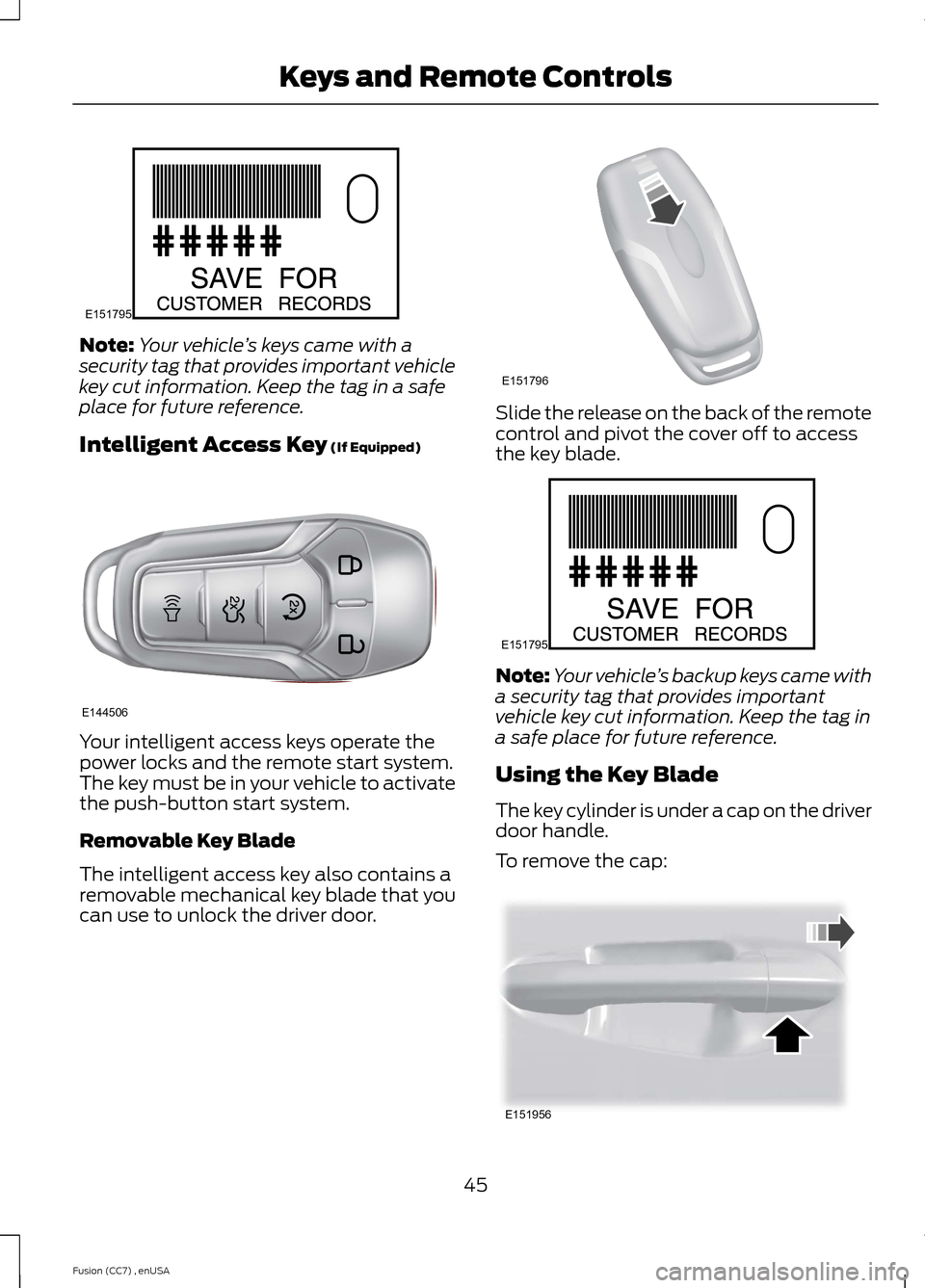
Note:Your vehicle’s keys came with asecurity tag that provides important vehiclekey cut information. Keep the tag in a safeplace for future reference.
Intelligent Access Key (If Equipped)
Your intelligent access keys operate thepower locks and the remote start system.The key must be in your vehicle to activatethe push-button start system.
Removable Key Blade
The intelligent access key also contains aremovable mechanical key blade that youcan use to unlock the driver door.
Slide the release on the back of the remotecontrol and pivot the cover off to accessthe key blade.
Note:Your vehicle’s backup keys came witha security tag that provides importantvehicle key cut information. Keep the tag ina safe place for future reference.
Using the Key Blade
The key cylinder is under a cap on the driverdoor handle.
To remove the cap:
45Fusion (CC7) , enUSAKeys and Remote ControlsE151795 E144506 E151796 E151795 E151956
Page 49 of 458
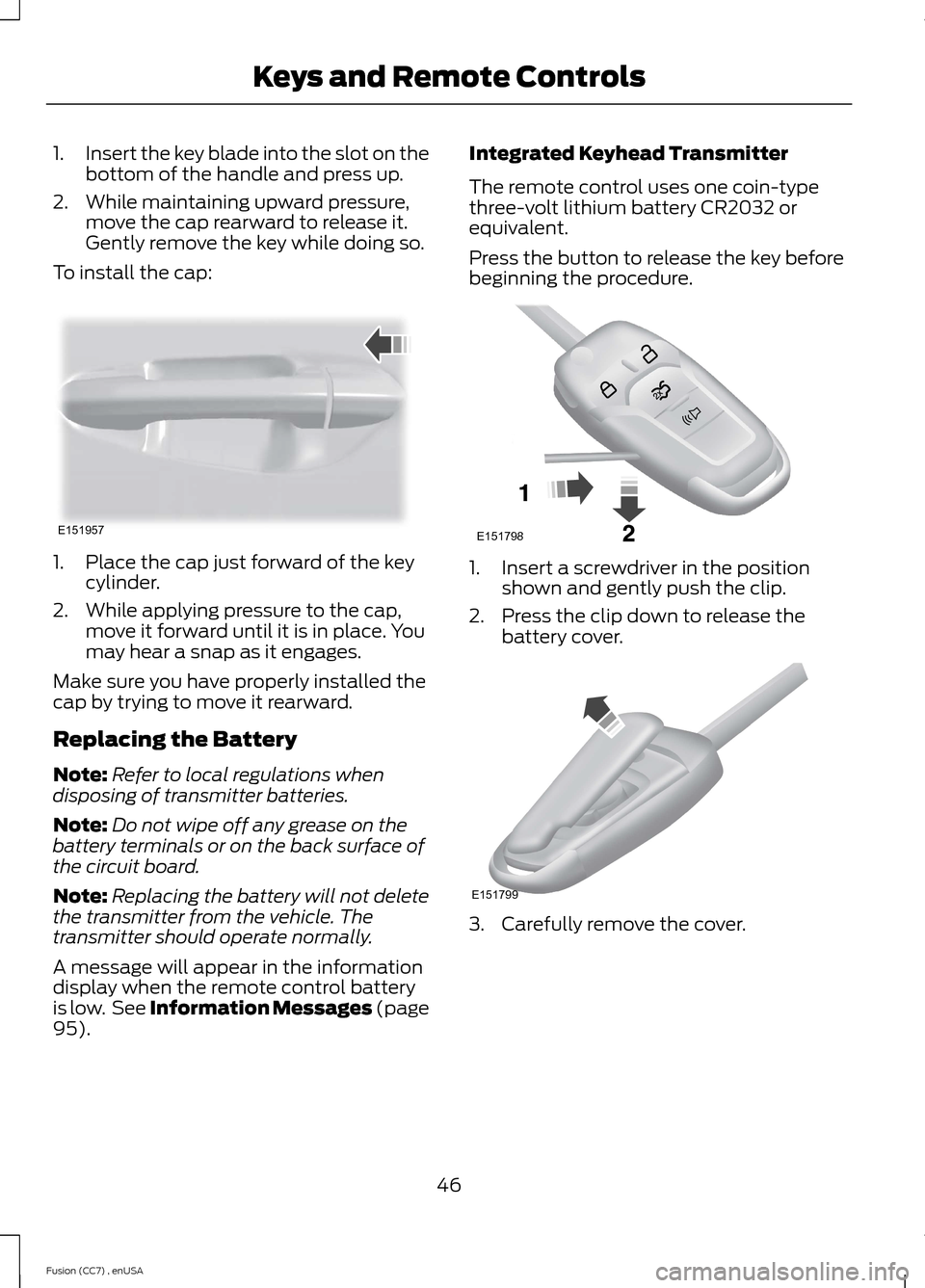
1.Insert the key blade into the slot on thebottom of the handle and press up.
2.While maintaining upward pressure,move the cap rearward to release it.Gently remove the key while doing so.
To install the cap:
1.Place the cap just forward of the keycylinder.
2.While applying pressure to the cap,move it forward until it is in place. Youmay hear a snap as it engages.
Make sure you have properly installed thecap by trying to move it rearward.
Replacing the Battery
Note:Refer to local regulations whendisposing of transmitter batteries.
Note:Do not wipe off any grease on thebattery terminals or on the back surface ofthe circuit board.
Note:Replacing the battery will not deletethe transmitter from the vehicle. Thetransmitter should operate normally.
A message will appear in the informationdisplay when the remote control batteryis low. See Information Messages (page95).
Integrated Keyhead Transmitter
The remote control uses one coin-typethree-volt lithium battery CR2032 orequivalent.
Press the button to release the key beforebeginning the procedure.
1.Insert a screwdriver in the positionshown and gently push the clip.
2.Press the clip down to release thebattery cover.
3.Carefully remove the cover.
46Fusion (CC7) , enUSAKeys and Remote ControlsE151957 E151798 E151799
Page 50 of 458
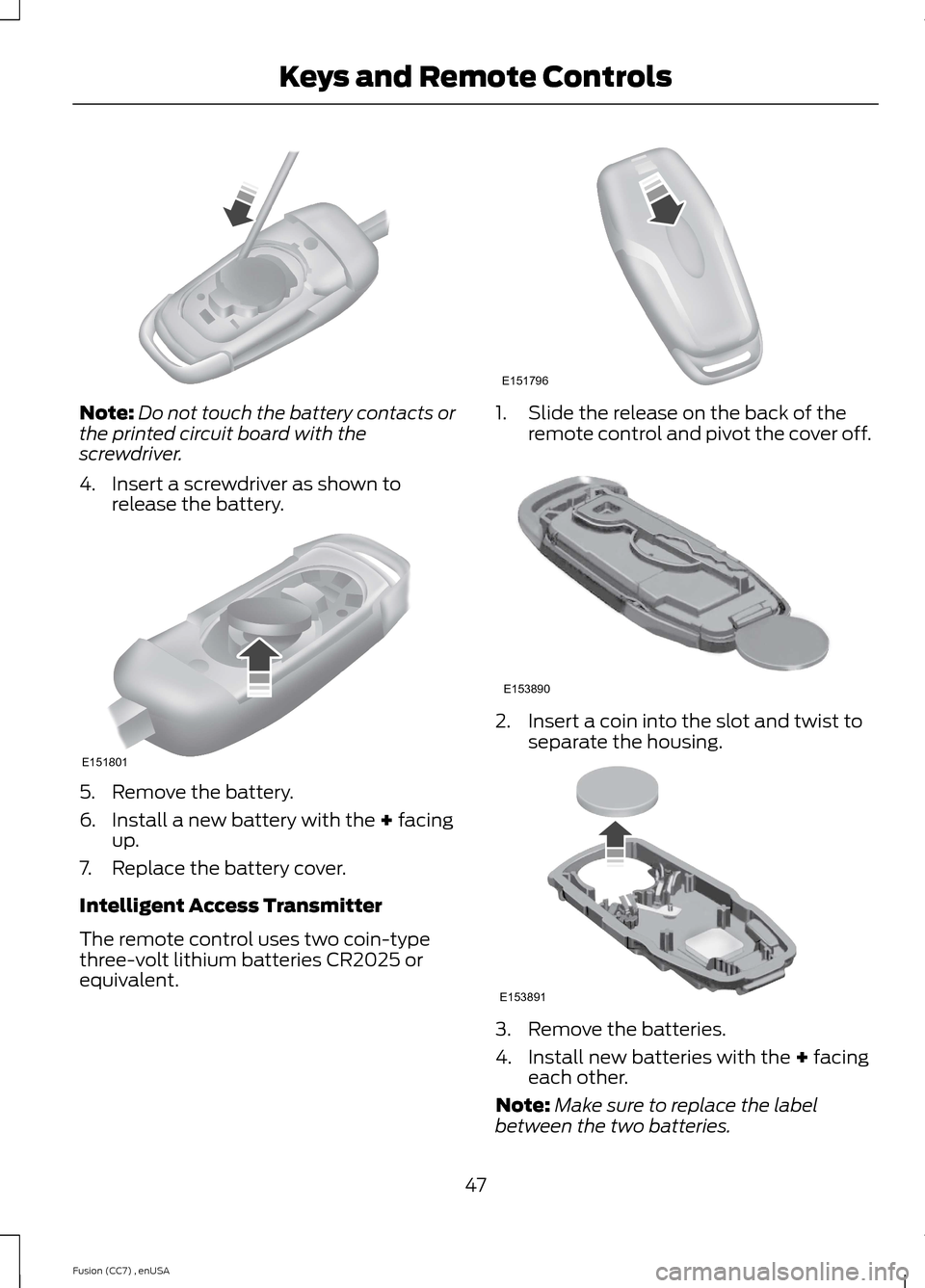
Note:Do not touch the battery contacts orthe printed circuit board with thescrewdriver.
4.Insert a screwdriver as shown torelease the battery.
5.Remove the battery.
6.Install a new battery with the + facingup.
7.Replace the battery cover.
Intelligent Access Transmitter
The remote control uses two coin-typethree-volt lithium batteries CR2025 orequivalent.
1.Slide the release on the back of theremote control and pivot the cover off.
2.Insert a coin into the slot and twist toseparate the housing.
3.Remove the batteries.
4.Install new batteries with the + facingeach other.
Note:Make sure to replace the labelbetween the two batteries.
47Fusion (CC7) , enUSAKeys and Remote Controls E151801 E151796 E153890 E153891